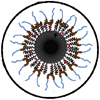Department of Physics and Astronomy: Publications and Other Research

Diandra Leslie-Pelecky Publications
Document Type
Article
Date of this Version
5-2000
Abstract
Mechanically milling SmCo5 powder significantly increases coercivity and remanence ratio by introducing defects; however, these defects can be removed by room-temperature aging, with a resultant decrease in coercivity. A series of (SmCo5) x:C1–x (0.15 ≤ x ≤1) samples has been fabricated to investigate the effect of C on oxidation protection and magnetic properties. SmCo5 was premilled for 1 h, then added to C powder and milled for times ranging from 15 min to 7 h. X-ray diffraction indicates the presence of crystalline graphite and SmCo5 for milling times ≤ 6 h and also shows the presence of fcc Co for milling times >7 h. The magnetic properties are very weakly dependent on milling time after the C addition, which is attributed to the lack of further grain refinement. The saturation magnetization scales linearly with the wt % of SmCo5. Remanence ratios are approximately 0.7 and independent of volume fraction. The maximum coercivity of 16.5 kOe is comparable to the maximum obtained by milling SmCo5 without C. Samples exposed to air for times up to two months show no decrease in coercivity or remanence ratio for x ≤ 0.70. The addition of C has no detrimental effect on the magnetic properties obtained by milling, except the expected reduction of Ms.


Comments
Copyright © 2000, American Institute of Physics. Used by permssion